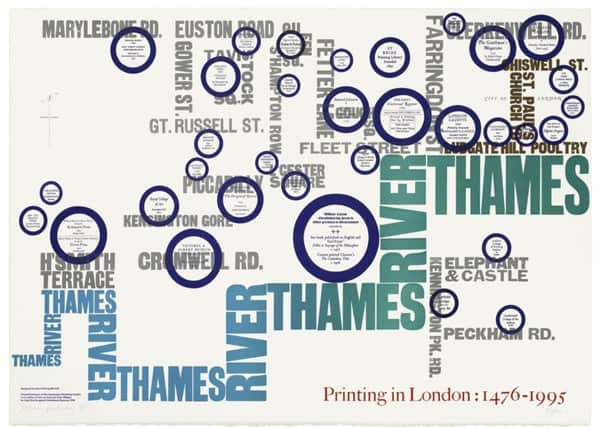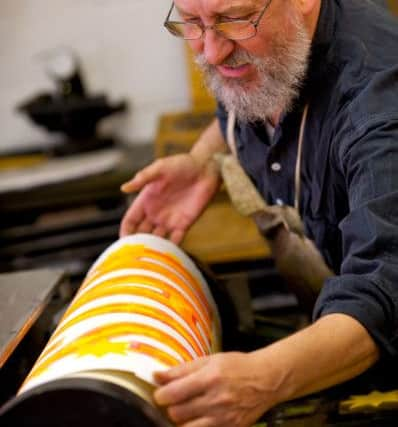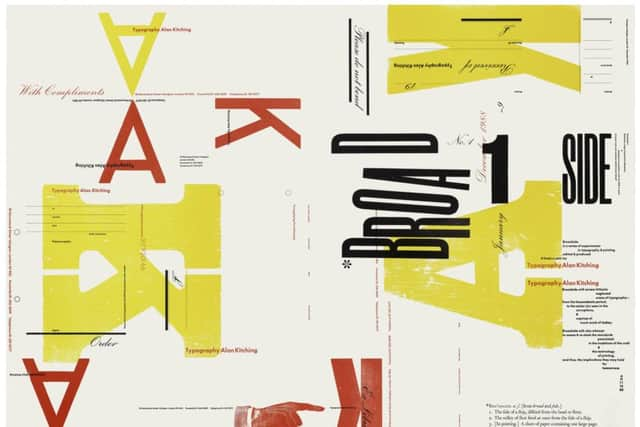A life in print: Alan Kitching


The fashion for fonts and hand-printed letters has become a style staple with sentimental phrases and words of wisdom featuring on everything from pictures and clothing to cards and posters.
The person we have to thank for breathing new life into the dying art of letterpress is Alan Kitching, whose work is celebrated in a new book “Alan Kitching: A Life in Letterpress”.
Advertisement
Hide AdAdvertisement
Hide AdHis decision to shun the computer keyboard and digital printing to return to his roots came as a surprise to his colleagues but it proved to be a trendsetting move.


The time-consuming technique using wooden blocks, metal letters and ink was part of his DNA. In 1956 at the age of 15, he started as an apprentice compositor at J.W. Brown & Son printers in Darlington.
He set brochures, dance tickets, pantomime posters, raffle tickets. “Everything had to be set in metal and printed on the press, as Gutenberg had done 550 years before,” says Kitching. “Nothing had changed.”
Ambition and support from his first wife and his creative family - his father was a joiner and his grandfather a sign writer - took him from the north east to the south, where he progressed from technician to establishing the printing unit at Watford School of Art with the help of world-renowned typographer Anthony Froshaug.
Advertisement
Hide AdAdvertisement
Hide AdIn 1976, as punk dawned and his freelance design work flourished, he teamed up with fellow graphic designers Derek Birdsall, Martin Lee and Andrew Gossett to form the famously progressive Omnific Studio Partnership.


It was here in 1985 that he and Derek set up a letterpress workshop, thanks largely to the demise of Sheffield-based printing press manufacturer Stephenson Blake.
“They were one of the world’s best manufacturers and we got wind of the closure. So me and Derek went up there and bought some of the kit,” says Alan.
They bought the largest proofing press the firm made along with some English type classics from the foundry, including Caslon Old Face with italics, 48 point Thorne Shaded, 48 point Marina Script, 36 point Chisel and various sizes of Modern 20 with italics. Alan contributed his Crown Folio 1835 and they added Futura type from the Barcelona Type Foundry.
Advertisement
Hide AdAdvertisement
Hide AdIn 1988 he left Omnithic, which was concentrating on digital printing, with a plan to reinvent the old ways for a new generation.


“I couldn’t just sit at a desk. In order for me to go forward as a designer, I had to go back to something I knew,” he says.
He took the old press and the type and went away to print.
“There were people doing traditional wedding invitations with letterpress but that was it. I wanted to do something different with it,” says Alan, who set up a workshop in Clerkenwell, long before the location was fashionable.
His original ideas, inspired by Modernism, along with his determination to reach technical perfection, gave letterpress a new spin. His distinctive typographical prints and powerful artwork set a trend. Alan was commissioned by everyone from The Guardian, Tate Modern and The National Theatre to the British Library, Penguin Books and Royal Mail.


Advertisement
Hide AdAdvertisement
Hide AdDerek Birdsall says: “With a wizard’s mix of inks and fonts, Alan produced unique posters and broadsheets, astonishing in their originality and freshness.”
He also began teaching letterpress printing techniques to students at the Royal College of Art.
.”That is what really helped generate interest. The students learned how to do it, went away and did their own thing with it. Letterpress has taken time to gain momentum again but it fits in with the trend for handmade items by artisans,” says Alan, who runs The Typography Workshop in Kennington.
At the age of 76, he shows no sign of slowing down. He still works and runs courses for beginners and established printers.
Advertisement
Hide AdAdvertisement
Hide Ad“It can be difficult and messy working with ink and blocks of wood but it has its own spirit and spontaneity,” he says. “That is something that computers cannot replicate.”
*Alan Kitching: the book and exhibition
Alan Kitching: A Life in Letterpress includes over 400 prints, a photo essay by Philip Sayer and a biographical monograph. It is published by Laurence King Publishers on April 7.
The first edition of the book will be a collector’s edition, featuring a book jacket that has been hand-printed by Alan himself and wrapped around the book as a removable dust jacket/print. Only 200 copies have been made and will only be available from Laurence King’s online shop priced £200. A separate special edition will also be available priced £75, www.laurenceking.com
An exhibition of Alan’s prints are on show at Somerset House, London, as part of the Pick Me Up Graphic Arts Festival from April 21.
Details of Alan’s letterpress courses are at www.thetypographyworkshop.com